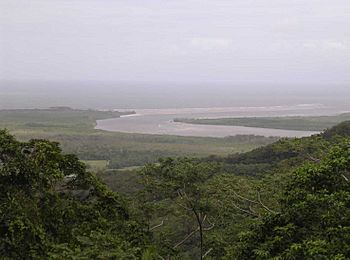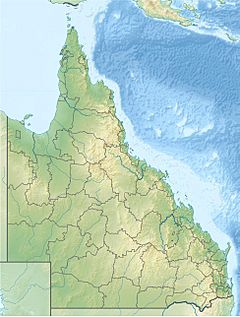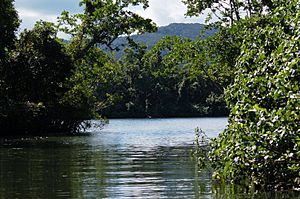Daintree River facts for kids
Quick facts for kids Daintree |
|
|---|---|

Daintree River mouth
|
|
|
Location of the Daintree River mouth in Queensland
|
|
| Country | Australia |
| State | Queensland |
| Region | Far North Queensland |
| Physical characteristics | |
| Main source | Daintree National Park, Great Dividing Range below Black Mountain 1,270 m (4,170 ft) 16°23′11″S 145°12′32″E / 16.38639°S 145.20889°E |
| River mouth | Coral Sea Cairns Marine Park 0 m (0 ft) 16°18′52″S 145°26′59″E / 16.31444°S 145.44972°E |
| Length | 140 km (87 mi) |
| Basin features | |
| Basin size | 2,107 km2 (814 sq mi) |
| Tributaries |
|
| National park | Daintree National Park; Cairns Marine Park |
The Daintree River is a river that starts in the Daintree Rainforest in Far North Queensland, Australia. It is located near Cape Tribulation, about 100 kilometers (62 miles) northwest of Cairns. This area is part of the UNESCO World Heritage–listed Wet Tropics of Queensland. Today, the Daintree River region is a popular place for tourists to visit.
Contents
Where Does the Daintree River Flow?
The Daintree River begins high up in the Great Dividing Range. It starts in Daintree National Park, below Black Mountain, about 1,270 meters (4,167 feet) above sea level. The river winds its way through the rainforest, flowing north, then east, then south, and then east again. In these parts, the water is fresh and clean.
Many animals, especially fish, gather in these fresh water areas. Two smaller streams join the Daintree River. After this, the river flows through the Cairns Marine Park. Here, it passes through thick mangrove swamps where the water becomes very salty. Finally, the Daintree River empties into the Coral Sea, north of Wonga Beach.
The river's mouth opens onto a huge sandbar that moves with the tides. The Daintree River drops 1,270 meters (4,167 feet) over its 127-kilometer (79-mile) journey. The area where the river collects its water, called the catchment area, covers about 2,107 square kilometers (814 square miles). About 33 square kilometers (13 square miles) of this area are estuary wetlands.
Why Does the Daintree River Flood?
The Daintree River is surrounded by tall mountains and deep valleys. Because of the weather in this area, the river can flood very quickly with little warning. This happens because of heavy rainfall in the mountain ranges, which are over 1,000 meters (3,281 feet) high. Strong storms from the nearby Coral Sea can also cause floods.
For example, in March 1996, record flood levels covered roads and properties throughout the Daintree region. In just 24 hours, 606 millimeters (23.9 inches) of rain fell. To help with flooding, two new causeways were built over Cape Tribulation Road in 2011. These raised sections of road make it easier to drive, even during heavy rain. The part at Cooper Creek was raised by 3 meters (10 feet).
What Makes the Daintree River Special?
People love to visit the Daintree area because of its ancient plants and beautiful scenery. It is also home to many different kinds of native animals and plants.
How Do People Cross the River?
There is no bridge to cross the Daintree River. So, visitors use the Daintree River Ferry. This is a special ferry that carries people and cars across the river, mainly for tourism. Other interesting places around the river include Black Mountain, the Daintree Range, Thornton Peak, and the Cape Tribulation Rainforest. The Daintree River is full of amazing tropical wildlife.
A Look at the Daintree River's Past
Who Lived Here First?
The Kuku Yulanji people are the Indigenous people who lived around the Daintree River. They were hunter-gatherers, meaning they found their food from nature. They lived in small groups and camped along the riverbanks. Their main food came from the plants and animals in the forest around the Daintree. It is believed that the Kuku Yulanji tribe lived by the Daintree River for over 9,000 years.
When Did Europeans Arrive?
It was always hard for ship captains to enter the Daintree River because of its shifting sandbar. Even Captain Cook missed the area when his ship was wrecked on the Great Barrier Reef. Europeans first saw the Daintree River in 1873. They were drawn to nearby areas because of the large amounts of gold found there.
George Elphinstone Dalrymple, who was the Queensland Gold Commissioner at the time, was the first European to visit the river. He named the river after Richard Daintree. Richard Daintree was an English geologist and an important representative for Queensland in London.
Crocodiles in the Daintree River
The Daintree River was ranked second in Queensland for crocodile sightings between 2000 and 2012. During that time, 145 sightings of saltwater crocodiles were recorded. Authorities always warn visitors to be very careful near the river. It is important not to go close to the riverbank and to stay inside boats. Swimming in the river is never safe.
Why is the Daintree River a World Heritage Site?
The Wet Tropics of Queensland, which includes the Daintree River, is a UNESCO World Heritage Site. This means it is recognized for its amazing natural value to the whole world. It shows important stages of Earth's history and ongoing natural processes. It also has special habitats for many different kinds of plants and animals. The Daintree River is part of the much larger Daintree Rainforest region in Northern Queensland, which covers about 894,000 hectares (2,209,120 acres).
Plants and Animals of the Daintree River
The Daintree River and its surroundings are home to some of the oldest types of animals and plants on Earth. The mountains and valleys around the river have protected many plant species from big climate changes.
One special example is the primitive She-oak, called Gymnostoma australianum. This tree looks like a pine tree and is the only type of Gymnostoma plant left in Australia. It is now only found in very small, isolated areas north of the Daintree River. This group of plants used to be found all over Gondwana, a supercontinent that existed long ago. Its relatives can still be found in parts of the Pacific and Southeast Asia.
There are five types of ringtail possums in the rainforests of North Queensland. The Cinereus ringtail possum (Pseudochirulus cinereus) is found almost only in the Daintree River area. In the park, you can find this possum in the high rainforests on Thornton Peak and near the upper parts of the Daintree and Mossman Rivers. It was once thought to be a lighter-colored version of the Herbert River ringtail possum. However, in 1989, it was identified as its own unique species.
Black and white Striped possums (Dactylopsila trivirgata) are quite common in the park. You can often see them in the lowlands along the coast north of the Daintree River. However, spotting one at night requires some luck and knowing where to look.
Because the river is so isolated, saltwater crocodiles have become very common. They were once hunted, but now they are protected by law. There have been reports of people being harmed by crocodiles in the Daintree River. Visitors are strongly advised to stay away from the riverbanks and never swim in the river.




